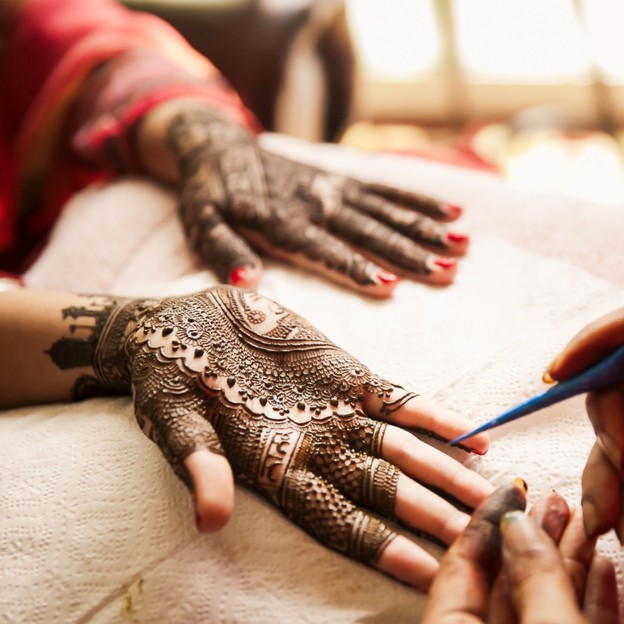 These 10 Mehendi Facts Will Amaze You to No End
These 10 Mehendi Facts Will Amaze You to No End

Mehendi, an ancient art form rooted in South Asian and Middle Eastern cultures, is much more than just a temporary tattoo. This intricate practice, involving the application of henna paste to create stunning, detailed patterns on the skin, is traditionally associated with weddings and special occasions. The designs, which vary from simple floral motifs to complex geometric patterns, symbolize joy, beauty, and spiritual awakening. There is much historical nuance behind this tradition that many do not know about.

Mehendi represents the bond of matrimony
The dark color of the mehendi is a symbol of the bride and groom’s intense love. It is also said that the longer the Mehendi color lasts on the bride’s skin, the more love and affection she will receive from her husband and his family.


Henna is over 5,000 years old
Henna, or mehendi, is the natural dye that has been used for thousands of years to decorate the skin and hair in traditions like the Mehendi ceremony. It has been used to symbolize good luck, love, and sensuality for thousands of years. Even the design style has a meaning: each varying design of henna is intricately chosen for the belief that it will bring good energy and luck and ward off evil, promoting fertility for the couple.

Mehendi has medicinal properties
Mehendi is applied to the skin of the bride because it is thought to relieve stress and enhance good health and blood circulation.

Jewish and Islamic people have beliefs around Henna as well
Both Jewish and Islamic traditions have incorporated henna into their practices because they believe it will ward off the evil eye. These cultures have started using henna in their ceremonies like weddings and childbirth to ward off evil and protect them from negative energy.


Henna is antiseptic
Henna is also known to have antiseptic qualities and can protect the bride and groom from viral diseases and other harmful illnesses, which is another reason why it is used on their skin prior to the wedding.

Henna was also used in ancient Egypt
Sources say that ancient Egyptians used henna in the mummification process of their Pharaohs, to indicate social status, bring awareness to spirituality, and help them have a good afterlife.

Moroccan rituals use henna as a talisman
The intricate designs are said to bring good luck and ward off evil spirits. However, henna also has religious significance in Morocco. It is believed that the Prophet Muhammad used henna to dye his beard and encouraged his followers to use it as well.

Essential oils are added to mehendi in Indian weddings
To make the mehendi paste, essential oils such as eucalyptus oil, lavender oil, and tea tree oil are added to the henna powder. Essential oils help darken the color of the mehendi and are also believed to have anti-bacterial and anti-fungal properties, which can prevent skin infections and allergies. The use of essential oils in mehendi is also considered to have a therapeutic effect, as the aroma can help to calm the nerves and reduce stress.

Mehendi even dates back to Indian mythology
In Indian mythology, Parvati, the goddess of love, fertility, and devotion, is said to have used mehendi to decorate her hands and feet in order to please her husband, Shiva, the god of destruction and transformation. According to legend, Parvati would spend hours creating intricate designs on her skin using mehendi, which was believed to symbolize the bond between a husband and wife. The tradition of using mehendi to decorate the bride’s hands and feet during Hindu weddings is said to have originated from this myth.

Mehendi has transformed from a ritual of tradition to also include fun for the whole family
Over time, the mehendi ritual has evolved to include more than just the bride and her close female relatives. Today, it has become a fun event for the entire family. In fact, it is not uncommon to see the groom and his family taking part in the ceremony. After the wedding, it is said that the groom is supposed to find his initials in the wife’s mehendi, which are hidden in the patterns of the design.
Related posts
- 6 Celebrity Engagements That Came To A Crashing Halt - Entertainment , Demi Moore , Engagement , Gwyneth Paltrow
- 7 Things That Can Cause Under Eye Puffiness and Dark Circles - Beauty , dark circles , eye puffiness
- People Expectations from a Gym - Fitness , cancellation policy , cleanliness , cost
- 10 Celebs with Gorgeous Natural Curls - Style & Fashion , curly hair , Hair , Nicole Kidman
- Concept of beauty in the modern age - Beauty , acceptance , Beauty , Botox
Latest posts
- Decluttering Before Deep Cleaning: A Comprehensive Guide - Home & Garden , Decluttering , home
- The Graceful Shift: Embracing 12 Transformative Changes After 50 - Beauty , health , mental health , psychology
- The Exit Strategy: Financial Steps to Reclaim Your Life from a Toxic Marriage - Lifestyle , mental health , Relationship , Toxic Marriage
- 10 Fun and Fulfilling Hobbies That Cost Next to Nothing - Lifestyle , hobby , mental health
- 12 Reasons Men Walk Away from Relationships—And What They Really Mean - Relationship , psychology , Relationship
- What Plus-Size Women Secretly Wish Their Partners Knew About Dating Them - Relationship , plus size , plus-size women , Relationship
- The Duchess We Adore: 10 Reasons Kate Middleton Continues to Inspire - Entertainment , Kate Middleton
- Cute vs. Hot: Decoding Male Appeal - Relationship , cute guy , hot guy , psychology
- 12 Things A Woman First Notices In a Man - Relationship , psychology , Relationship
- The Impact of Long-term Singlehood: 6 Positive and 6 Negative Effects - Lifestyle , mental health , psychology , Singlehood